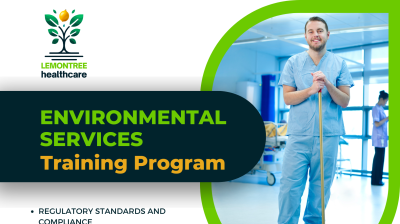ENVIRONMENTAL SERVICES TRAINING PROGRAM
- INTERACADEMY Administrator |

The Environmental Services Training Program is designed to ensure our team maintains the highest standards of cleanliness and safety at RMC Hospital, directly impacting patient health and satisfaction.
Justification
Providing a clean and safe environment is critical in healthcare settings to prevent infections and promote healing. This program aligns our services with OSHA and CDC guidelines, fulfilling regulatory requirements and enhancing our service quality.
Course Information
Objectives
General Objective
To train environmental services staff in effective cleaning, disinfection, and safety practices that meet regulatory standards and support patient care excellence.
Specific Objectives
- Comprehend and apply OSHA and CDC guidelines relevant to environmental services.
- Execute proper cleaning and disinfection protocols.
- Safely handle hazardous materials and waste.
- Implement infection control measures.
Foster effective communication with healthcare staff and patients.
Curricular Structure
- REGULATORY STANDARDS AND COMPLIANCE
- Overview of OSHA and CDC regulations.
- Overview of OSHA and CDC Regulations
- Understanding OSHA Standards for Healthcare Settings
- CDC Guidelines: Infection Control in Healthcare
- Cleaning and Disinfection Procedures
- Handling Hazardous Materials and Waste
- Understanding hospital policies and procedures.
- Understanding Hospital Policies and Procedures
- Safety and Risk Management Policies
- Infection Control Policies
- Patient Privacy and Confidentiality
- Quality Control and Continuous Improvement
- Legal implications of non-compliance.
- Legal Implications of Non-Compliance
- OSHA Regulations and Non-Compliance
- Non-Compliance with Infection Control Standards
- Hazardous Waste Non-Compliance
- Preventing Non-Compliance
- INFECTION CONTROL PRINCIPLES
- Chain of infection and how to break it.
- Chain of Infection: Understanding the Basics
- Breaking the Chain at the Infectious Agent and Reservoir
- Breaking the Chain at the Portal of Exit
- Breaking the Chain at the Mode of Transmission
- Breaking the Chain at the Portal of Entry and Susceptible Host
- Standard and transmission-based precautions.
- Introduction to Standard and Transmission-Based Precautions
- Standard Precautions: Hand Hygiene and PPE
- Contact Precautions: Preventing Direct and Indirect Transmission
- Droplet Precautions: Managing Respiratory Infections
- Airborne Precautions: Protecting Against Airborne Pathogens
- Hand hygiene and PPE usage.
- Introduction to Hand Hygiene and PPE Usage
- Proper Hand Hygiene Techniques
- Types of PPE and When to Use Them
- How to Don and Doff PPE Properly
- Common Mistakes in Hand Hygiene and PPE Usage
- CLEANING AND DISINFECTION PROCEDURES
- Cleaning vs. disinfection vs. sterilization.
- Introduction to Cleaning, Disinfection, and Sterilization
- Cleaning: The First Step in Infection Control
- Disinfection: Killing Harmful Pathogens
- Sterilization: Eliminating All Microbial Life
- Choosing the Right Method: Cleaning, Disinfection, or Sterilization
- Proper use of cleaning agents and equipment.
- Introduction to Proper Use of Cleaning Agents and Equipment
- Types of Cleaning Agents
- Types of Cleaning Equipment
- Safety Precautions When Using Cleaning Agents and Equipment
- Best Practices for Effective Cleaning
- Room turnover procedures.
- Introduction to Room Turnover Procedures
- Step 1: Initial Room Inspection and Waste Removal
- Step 2: Surface Cleaning and Disinfection
- Step 3: Handling Linens and Bedding
- Step 4: Final Inspection and Restocking
- HAZARDOUS MATERIALS AND WASTE MANAGEMENT
- Identifying hazardous substances.
- Introduction to Hazardous Substances in Healthcare
- Chemical Hazards in Healthcare
- Biological Hazards in Healthcare
- Radioactive Hazards in Healthcare
- General Safety Practices for Handling Hazardous Substances
- Safe handling and disposal techniques.
- Introduction to Safe Handling and Disposal Techniques
- Safe Handling of General Waste
- Handling and Disposal of Biological Waste
- Handling and Disposal of Hazardous Waste
- General Best Practices for Safe Handling and Disposal
- Spill response and emergency procedures.
- Introduction to Spill Response and Emergency Procedures
- Spill Response for Biological Hazards
- Spill Response for Chemical Hazards
- Spill Response for Hazardous Waste
- Emergency Procedures for Large or Dangerous Spills
- SAFETY AND ERGONOMICS
- Injury prevention strategies.
- Introduction to Injury Prevention in Healthcare
- Safe Lifting and Moving Techniques
- Ergonomics in the Workplace
- Preventing Slips, Trips, and Falls
- Injury Reporting and Safety Culture
- Safe lifting and movement practices.
- Introduction to Safe Lifting and Movement Practices
- Proper Body Mechanics for Safe Lifting
- Using Assistive Devices for Lifting and Moving
- Working as a Team for Safe Lifting
- Preventing Repetitive Strain Injuries
- Reporting incidents and near-misses.
- Introduction to Incident and Near-Miss Reporting
- Recognizing and Responding to Incidents
- Understanding and Reporting Near-Misses
- The Reporting Process
- Using Reports to Improve Safety Protocols
- COMMUNICATION AND PROFESSIONALISM
- Interacting with patients and staff.
- Introduction to Professional Interactions in Healthcare
- Effective Communication with Patients
- Collaborative Communication with Staff
- Maintaining Boundaries in Interactions
- Handling Challenging Interactions
- Cultural sensitivity and confidentiality.
- Introduction to Cultural Sensitivity and Confidentiality
- Cultural Sensitivity in Patient Interactions
- Cultural Sensitivity in Staff Interactions
- Understanding Confidentiality in Healthcare
- Balancing Cultural Sensitivity and Confidentiality
- Conflict resolution.
- Introduction to Conflict Resolution in Healthcare
- Identifying Sources of Conflict
- Steps for Effective Conflict Resolution
- Preventing Conflict in the Workplace
- Conflict De-escalation Techniques
Methodology
Training combines online learning through Chamilo LMS with interactive content and in-person workshops for practical skill development.
Evaluation
Assessment methods include:
- Module-specific online quizzes.
- Practical skill assessments during workshops.
- Final competency evaluation requiring demonstration of key skills.
- Certificates awarded upon successful completion.
Coaches
INTERACADEMY Administrator
